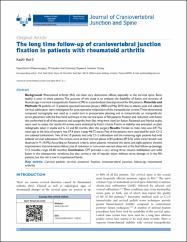| dc.contributor.author | Kotil, Kadir | en_US |
| dc.date.accessioned | 2016-07-13T10:57:17Z | |
| dc.date.available | 2016-07-13T10:57:17Z | |
| dc.date.issued | 2013 | |
| dc.identifier.citation | Kotil, K. (2013). The long time follow-up of craniovertebral junction fixation in patients with rheumatoid arthritis. Journal of Craniovertebral Junction and Spine. 3. 2, 42-46. | en_US |
| dc.identifier.issn | 0974-8237 | |
| dc.identifier.issn | 0976-9285 | |
| dc.identifier.uri | https://hdl.handle.net/20.500.12294/523 | |
| dc.identifier.uri | http://dx.doi.org/10.4103/0974-8237.116532 | |
| dc.description.abstract | Background: Rheumatoid arthritis (RA) can have very destructive effects, especially in the cervical spine. Bone quality is poor in these patients. The purpose of this study is to evaluate the feasibility of fusion and accuracy of fl uoroscopy in cervical transpedicular fi xation (CPF) in a standardized clinical protocol for RA patients. Materials and Methods: 96 pedicles of 15 patients operated between January 2000 and May 2010 due to atlanto-axial and subaxial cervical subluxation were investigated for post-operative malposition of the transpedicular screws. Three-dimensional computed tomography was used as a useful tool in preoperative planning and in transarticular or transpedicular screw placement with the free hand technique in the cervical spine of RA patients. Fixation and reduction with fusion was performed in all of the patients, and autogrefts from iliac wing were used for fusion. Ranawat’s and Nurick scales were used to assess the results. All screws were evaluated by Kast’s criteria. Fusion or stability was evaluated on plain radiographs taken 3 weeks and 6, 12 and 60 months after the surgery. Results: Female to male ratio was 6/9. The mean age at the time of surgery was 57.4 years (range 44-72 years). Five of the patients were operated for both C1-2 and subaxial subluxation. Two of the 15 patients had only C1-2 subluxation and the remaining eight patients had only subaxial cervical subluxation. The screws were at their correct places in 84 pedicles (87.5.%) while minor breach was detected in 9 (10.9%). According to Ranawat’s criteria, seven patients remained the same, and eight patients showed improvement. Instrumentation failure, loss of reduction or non-union was not observed at the fi nal follow-up (average 31.5 months; range 24-60 months). Conclusion: CPF provides a very strong three column stabilization and solid fusion in the osteoporotic vertebrae, but also carries a risk of vascular injury without nerve damage or in the RA patients, but the risk is low in experienced hands. | en_US |
| dc.language.iso | eng | en_US |
| dc.publisher | Elsevier | en_US |
| dc.relation.ispartof | Journal of Craniovertebral Junction and Spine | en_US |
| dc.rights | info:eu-repo/semantics/openAccess | en_US |
| dc.subject | Cervical Pedicle | en_US |
| dc.subject | Cervical Posterior Fi Xation | en_US |
| dc.subject | Craniovertebral Junction | en_US |
| dc.subject | Follow-up | en_US |
| dc.subject | Rheumatoid Arthritis | en_US |
| dc.title | The long time follow-up of craniovertebral junction fixation in patients with rheumatoid arthritis | en_US |
| dc.type | article | en_US |
| dc.department | İstanbul Arel Üniversitesi, Sağlık Bilimleri Yüksekokulu, Fizyoterapi ve Rehabilitasyon Bölümü. | en_US |
| dc.authorid | TR13239 | en_US |
| dc.identifier.volume | 3 | en_US |
| dc.identifier.issue | 2 | en_US |
| dc.identifier.startpage | 42 | en_US |
| dc.identifier.endpage | 46 | en_US |
| dc.relation.publicationcategory | Makale - Uluslararası Hakemli Dergi - Kurum Öğretim Elemanı | en_US |
| dc.institutionauthor | Kotil, Kadir | en_US |


















